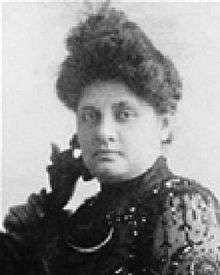Abigail Kuaihelani Campbell
| Abigail Kuaihelani Campbell | |
|---|---|
 | |
| Born |
August 22, 1858 Lahaina, Kingdom of Hawaii |
| Died |
November 1, 1908 (aged 50) Honolulu, Kingdom of Hawaii |
| Nationality | Kingdom of Hawaii |
| Occupation | Political leader |
| Spouse(s) |
James Campbell Samuel Parker |
| Children | Abigail Campbell Kawānanakoa + others |
| Parent(s) |
John Maipinepine Bright Mary Kamai Hanaike |
Abigail Kuaihelani Maipinepine Bright, Mrs. Campbell (1858–1908) was a member of the nobility of the Kingdom of Hawaii. During her life, she married two powerful American businessmen, particularly adding to the success of her first husband, James Campbell, and giving him descendants. Among their grandchildren were three heirs to the throne of the kingdom of Hawaii.
Life
Abigail Kuaihelani Maipinepine Bright was born on August 22, 1858 on Lahaina, Maui.[1][2] Her mother was Mary Kamai Hanaike and her father was John Maipinepine Bright.[3][4] She is descended from the Kalanikini line of Maui chieftains, with some European-American ancestry on her father's side.[5]


On October 30, 1877, she married Scotch-Irish American businessman James Campbell (1826–1900), who became one of the largest landowners in the islands.[6] Their children were Margaret (1880–1882); Abigail (1882–1945), who became better-known as Abigail Campbell Kawānanakoa after marrying a Hawaiian prince; Alice Kamokilaikawai (1884–1971) (see Alice Campbell); James, Jr. (1886–1889); Muriel (Mrs. Robert K.) Shingle (1890–1951); Royalist (1893–1896); and Beatrice (Mrs. Francis) Wrigley.[7]
Daughter Alice Kamokila Campbell became active in the anti-statehood movement after the United States annexed Hawaiʻi, making it a Territory.[8] Daughter Margaret, son James Campbell, Jr. and two other daughters died young.[4] James Campbell, Sr. died in 1900 and bequeathed his widow one-third of the estate during her lifetime.
After the 1893 overthrow of the Kingdom of Hawaii, Abigail Campbell and Emma Nāwahī, wife of Joseph Nāwahī, became leaders of the Hawaiian native movement for protesting the takeover, called Hui Hawaiʻi Aloha ʻĀina o Na Wahine (Hawaiian Women's Patriot League).[9] She became its president.
On January 4, 1902, widow Abigail Kuaihelani Campbell married widower Samuel Parker, half owner of Parker Ranch.[10] They had a private ceremony in the Occidental Hotel of San Francisco with a judge presiding. The Campbell estate owned the St. James Hotel in San Jose, California. At the time, Abigail Campbell was also preparing to celebrate the wedding of her daughter Abigail to Prince David Kawānanakoa, which took place two days later. The Parkers traveled to Washington, D.C..[11] They returned to California February 2, 1902; it was rumored that Parker would be appointed as the next governor of the Territory of Hawaii.[12] George R. Carter was appointed instead. They had no children.
Campbell-Parker died November 1, 1908 after surgery for breast cancer.[13]
Family tree
| Kawānanakoa family tree | |||||||||||||||||||||||||||||||||||||||||||||||||||||||||||||||||||||||||||||||||||||||||||||||||||||||||||||||||||||||||||||||||||||||||||||||||||||||||||||||||||||||||||||||||||||||||||||||||||||||||||||||||||||||||||||||||||||||||||||||||||||||||||||||||||||||||||||||||||||||||||||||
|---|---|---|---|---|---|---|---|---|---|---|---|---|---|---|---|---|---|---|---|---|---|---|---|---|---|---|---|---|---|---|---|---|---|---|---|---|---|---|---|---|---|---|---|---|---|---|---|---|---|---|---|---|---|---|---|---|---|---|---|---|---|---|---|---|---|---|---|---|---|---|---|---|---|---|---|---|---|---|---|---|---|---|---|---|---|---|---|---|---|---|---|---|---|---|---|---|---|---|---|---|---|---|---|---|---|---|---|---|---|---|---|---|---|---|---|---|---|---|---|---|---|---|---|---|---|---|---|---|---|---|---|---|---|---|---|---|---|---|---|---|---|---|---|---|---|---|---|---|---|---|---|---|---|---|---|---|---|---|---|---|---|---|---|---|---|---|---|---|---|---|---|---|---|---|---|---|---|---|---|---|---|---|---|---|---|---|---|---|---|---|---|---|---|---|---|---|---|---|---|---|---|---|---|---|---|---|---|---|---|---|---|---|---|---|---|---|---|---|---|---|---|---|---|---|---|---|---|---|---|---|---|---|---|---|---|---|---|---|---|---|---|---|---|---|---|---|---|---|---|---|---|---|---|---|---|---|---|---|---|---|---|---|---|---|---|---|---|---|---|---|---|---|---|---|---|---|---|---|---|---|---|---|---|---|---|---|---|
| |||||||||||||||||||||||||||||||||||||||||||||||||||||||||||||||||||||||||||||||||||||||||||||||||||||||||||||||||||||||||||||||||||||||||||||||||||||||||||||||||||||||||||||||||||||||||||||||||||||||||||||||||||||||||||||||||||||||||||||||||||||||||||||||||||||||||||||||||||||||||||||||
| Notes:
| |||||||||||||||||||||||||||||||||||||||||||||||||||||||||||||||||||||||||||||||||||||||||||||||||||||||||||||||||||||||||||||||||||||||||||||||||||||||||||||||||||||||||||||||||||||||||||||||||||||||||||||||||||||||||||||||||||||||||||||||||||||||||||||||||||||||||||||||||||||||||||||||
References
| Wikimedia Commons has media related to Abigail Kuaihelani Campbell. |
- ↑ "Death of Mrs. Campbell-Parker at the Hospital". Hawaiian Gazette. Honolulu. November 8, 1908. p. 1. Retrieved April 22, 2012.
- ↑ Richard A. Hawkins (2003). "Princess Abigail Kawananakoa: the Forgotten Territorial Native Hawaiian Leader". Hawaiian Journal of History. 37. Hawaii Historical Society. pp. 163–77. hdl:10524/354.
- ↑ "Abigail Kuaihelani Maipinepine". Our Family History and Ancestry. Families of Old Hawaii. Retrieved 2010-03-25.
- 1 2 "James Campbell, Esq." (PDF). James Campbell Company LLC. 2003. Retrieved 2010-03-23.
- ↑ Kapikauinamoku (December 11, 1955). "The Story of Maui Royalty: Lunaliloʻs Dynasty Is Represented By Amalus". The Honolulu Advertiser.
- ↑ "Marriage record, Oahu(1832–1910)". state archives digital collections. state of Hawaii. Retrieved 2010-03-01.
- ↑ Barbara Bennett Peterson (1984). Notable Women of Hawaii. University of Hawaii Press. p. 209. ISBN 0-8248-0820-7.
- ↑ John S. Whitehead (1993). "Anti-Statehood Movement and the Legacy of Alice Kamokila Campbell". Hawaiian Journal of History. 27. Hawaii Historical Society. pp. 43–63. hdl:10524/218.
- ↑ Noenoe K. Silva (2004). Aloha betrayed: Native Hawaiian Resistance to American Colonialism. Duke University Press. p. 130. ISBN 978-0-8223-3349-4.
- ↑ "A day's weddings". New York Times. January 5, 1902. Retrieved 2010-03-25.
- ↑ "San Jose Lady has a Responsible Position in Prospect". The Evening News. San Jose, California. January 31, 1902. Retrieved 2010-03-25.
- ↑ "Prince David and His Bride Are En Route to Island Home". The Evening News. San Jose, California. February 1, 1902. Retrieved 2010-03-25.
- ↑ "Death of Mrs. Campbell-Parker at the Hospital". Hawaiian Gazette. November 3, 1908. Retrieved June 13, 2010. (reprinted from Honolulu Advertiser)